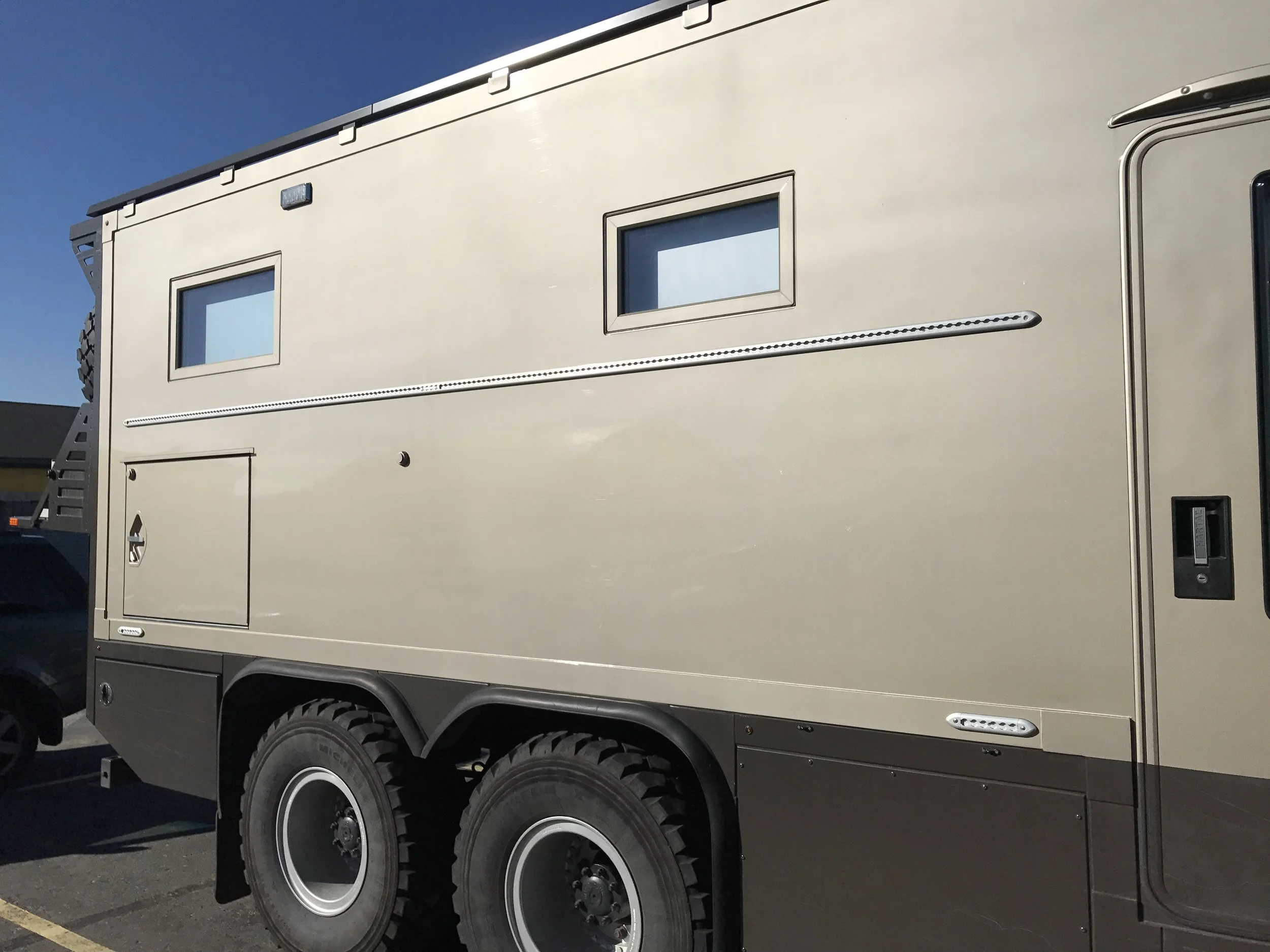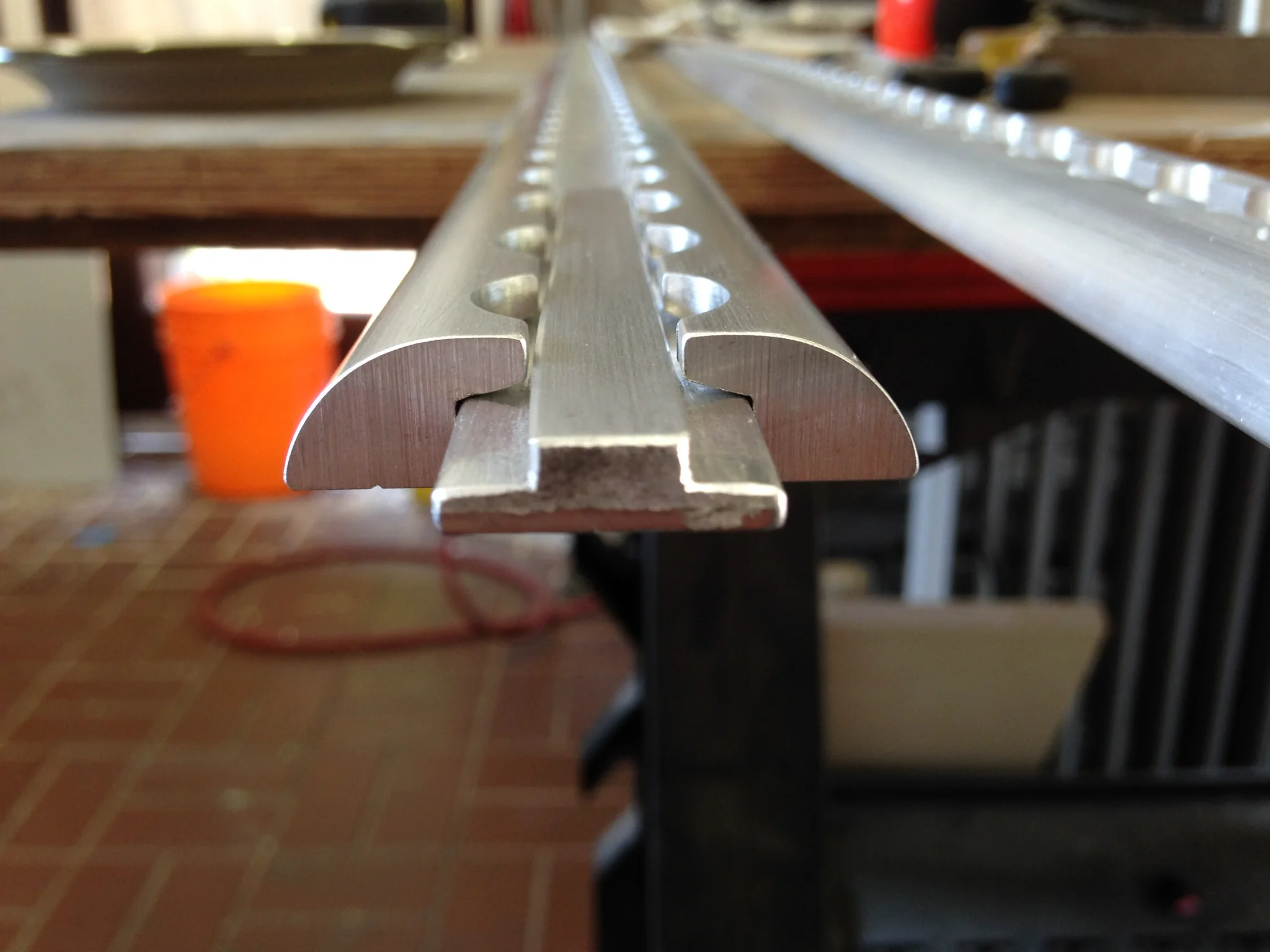Awning Solution
We need An Awning, So Which Is Best
One of the things we had to make a decision on when we were designing the truck was what we were going to do for a shade awning. Oddly enough, it wasn’t that easy a decision. You see, we’ve had quite a lot of experience with awnings, and the one thing we learned for sure is that the price of the awning doesn’t determine how good it is.
The large and expensive Girard awning on the motorhome provided little shade in this situation.
Large Awnings
The giant cantilevered awnings on our motorhome, which are perhaps the most expensive awnings available for a vehicle, were essentially useless for shade if the sun wasn’t high in the sky, like it is during summer. Sure they covered an area of forty feet by twelve feet, but they were high up on the edge of the roof. This meant that use during the winter months, when the sun is low in the sky, was marginal at best.
The other issue with large awnings, especially cantilevered ones, is that they are essentially a giant sail. Even a moderate wind can affect them. More than a few times we had a gust come out of nowhere and lift the fabric of the awning, causing the spring loaded arms to fold and retract. The resultant vertical ballooning of the fabric would see it towering five feet above the roof of the coach. If the wind gust stopped as quickly as it formed, the fabric would collapse and the arms would snap back to their full length with ferocious velocity. It wouldn’t take many of these events before a mechanical failure in the arms occurred.
The economical ARB awning shown here barely providea enough shade for two chairs.
Small Awnings
In contrast to the large awnings, and in the right situations, small awnings can be a real asset. For the most part they’re light, compact and quite durable. And they do provide shade when needed. But the footprint of the shade can also be small, meaning it reduces the usable area of shade to but a few individuals. As well as that, the shade moves as the sun tracks across the sky, and because of the small foot print, one can find themselves repositioning often to maintain their cover. Especially in the winter sun when it is low, and tracks across the sky faster.
Small awnings can also be fairly inexpensive, although some, like the ones from South Africa and Europe, can be surprisingly expensive. Sure, they may be well made, but this fact doesn’t really ease the strain for those who are working to a budget. In our case, we elected to use the ARB awnings on the adventure trailer we built to tow behind our Land Rover Defender 90. Three of the ARB awnings ($275) could be bought for less money than a single Eezi-Awn ($920) unit of the same size, and our observation was that the quality of the ARB awning was more than satisfactory for our needs.
Wall Mounted Awnings
On most motorhomes, and indeed on most expedition/adventure trucks of a larger size, awnings are mounted on the side wall of the cabin. They can be mounted lower down, so their shade effect is superior to roofline mounted awnings. But they have one achilles heal. Tree branches.
Even this brand of awning, which is considered by most to be a high quality brand, presents a forward end that could easily catch on things when in the woods.
Now if you are only going to use your vehicle on the plains, or in desert areas that have a conspicuous absence of sturdy trees, then the wall mounted awnings would serve you well. But if you plan to motor down forest service roads and other narrower tracks, then wall mounted awnings that are proud of the wall surface can be in real jeopardy. Branches sliding down the side of the vehicle can get caught on the forward edges of the awning and cause severe damage to the awning, the wall or both. In some installations, where the builder has knowledge of such things, they incorporate a brach deflector at the leading edge of the awning to reduce the likelihood of something getting caught.
The Best Solution for Us
After considering our previous experience with different awnings, and the effect height has on their effectiveness, we decided to go with a wall mounted solution. But not one that would be considered a conventional solution generally seen here in North America.
Commonly seen on trucks built in Europe, logistic track (L-track) provides a way to attach an awning to the side wall, and remove it when it’s not required. Also known as airline track, L-track comes in various profiles for use under different circumstances. For our use, we chose a surface mount, broad base design. This would give us the largest glueing footprint, and the cross-sectional shape makes it particularly resistant to being caught on anything that might slide by it. Although there are a number of different manufacturers for this product, we bought ours from a company called Macs Custom Tie Downs located in Sagle, Idaho. (http://www.macscustomtiedowns.com)
By using L-track, almost anything can be used as an awning, even something as simple as a tarp. A great idea that we got from friend who owns a magnificent three axle truck, custom made to his design by Action Mobil in Saalfelden, Austria, was an awning purchased from, of all places, IKEA. And at CDN$30, it has to be the most cost effective solution we’ve ever come across. It provides a triangular canvas area of 163” x 141”. Unfortunately, since buying ours from IKEA, the product has be made obsolete. But in any event, if the one we have wears out, it’s simple enough to make our own awning by simply buying some Sunbrella fabric and sewing the edges ourselves. When the time comes for us to do this, we’ll change and go for a rectangular awning shape. A bit more to string up, but much more usable shade.
Although this awning looks quite close to the ground, the wall track is actually 9 feet high, and the outboard corner is being held while standing on a step stool.
Wall Track Installation
We bought the track in eight foot lengths from Mac’s Tie Downs a year ago, but had too many other priorities for the truck to get to it right away. The installation of the wall track took place over a few days. But before that could happen we had to machine the L-track to the correct dimensions, and send it out to be anodized. Otherwise the raw aluminum track would corrode over time, and look unsightly in fairly short order.

































